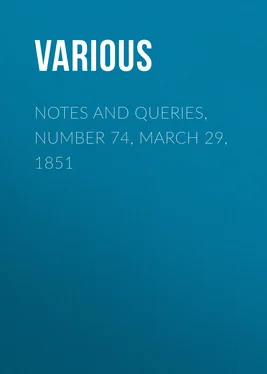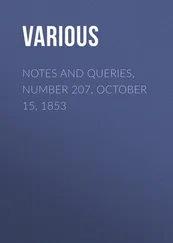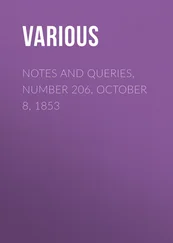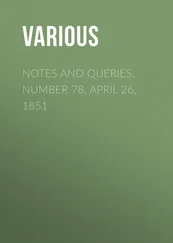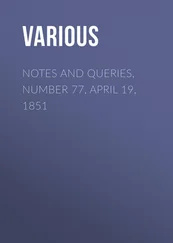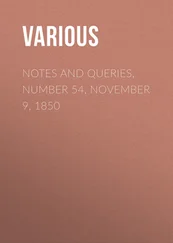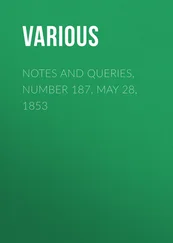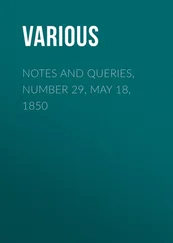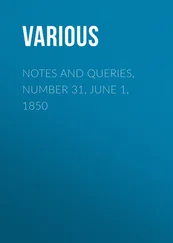Various - Notes and Queries, Number 74, March 29, 1851
Здесь есть возможность читать онлайн «Various - Notes and Queries, Number 74, March 29, 1851» — ознакомительный отрывок электронной книги совершенно бесплатно, а после прочтения отрывка купить полную версию. В некоторых случаях можно слушать аудио, скачать через торрент в формате fb2 и присутствует краткое содержание. Жанр: foreign_antique, periodic, foreign_edu, на английском языке. Описание произведения, (предисловие) а так же отзывы посетителей доступны на портале библиотеки ЛибКат.
- Название:Notes and Queries, Number 74, March 29, 1851
- Автор:
- Жанр:
- Год:неизвестен
- ISBN:нет данных
- Рейтинг книги:4 / 5. Голосов: 1
-
Избранное:Добавить в избранное
- Отзывы:
-
Ваша оценка:
- 80
- 1
- 2
- 3
- 4
- 5
Notes and Queries, Number 74, March 29, 1851: краткое содержание, описание и аннотация
Предлагаем к чтению аннотацию, описание, краткое содержание или предисловие (зависит от того, что написал сам автор книги «Notes and Queries, Number 74, March 29, 1851»). Если вы не нашли необходимую информацию о книге — напишите в комментариях, мы постараемся отыскать её.
Notes and Queries, Number 74, March 29, 1851 — читать онлайн ознакомительный отрывок
Ниже представлен текст книги, разбитый по страницам. Система сохранения места последней прочитанной страницы, позволяет с удобством читать онлайн бесплатно книгу «Notes and Queries, Number 74, March 29, 1851», без необходимости каждый раз заново искать на чём Вы остановились. Поставьте закладку, и сможете в любой момент перейти на страницу, на которой закончили чтение.
Интервал:
Закладка:
Various
Notes and Queries, Number 74, March 29, 1851 / A Medium of Inter-communication for Literary Men, Artists, Antiquaries, Genealogists, etc
Notes
ON PORTRAITS OF DISTINGUISHED ENGLISHMEN
In submitting to you the following brief observations, it is neither my wish nor intention to undervalue or disparage the labours of Horace Walpole, and Granger, and Pennant, and Lodge, and the numerous writers who have followed in their train, and to whom we are so much indebted for their notices of a great variety of original portraits of distinguished Englishmen, which still adorn the mansions of our aristocracy, and are found in the smaller collections throughout the realm. But I may be permitted to express my surprise and regret that in this age of inquiry no general catalogue of these national treasures should ever have been published. It is true that the portraits, as well as the other objects of attraction in our royal palaces, have been described in print with tolerable accuracy, and some good accounts are to be met with of the pictures at Woburn, and Blenheim, and Althorpe, and many of the residences of the nobility which can boast their local historian. We are, however, in most cases obliged to content ourselves with the meagre information afforded by county topography, or such works as the Beauties of England , Neale's Country Seats , and unsatisfactory guide-books.
No one, then, can doubt that such a compilation as I am advocating would prove a most welcome addition to our increasing stock of historical lore, and greatly assist the biographer in those researches upon which, from no sufficient materials being at hand, too much time is frequently expended without any adequate result. A catalogue would also tend to the preservation of ancient portraits, which, by being brought into notice, would acquire more importance in the estimation of the possessors; and in the event of any old houses falling into decay, the recorded fact of certain pictures having existed there, would cause them to be inquired after, and rescue them from destruction. Opportunities would likewise be afforded of correcting misnomers, and testing the authenticity of reputed likenesses of the same individual; further, the printed lists would survive after all the family traditions had been forgotten, and passed away with the antiquated housekeeper, and her worn-out inventory. The practice, too, of inscribing the names of the artist and person represented on the backs of the frames, would probably be better observed; and I may mention as a proof of this precaution being necessary, the instance of a baronet in our day having inherited an old house full of pictures, which were one and all described, in laconic and most unsatisfactory terms, as " Portraits of Ladies and Gentlemen Unknown ." The losses of works of art and interest by the lamentable fires that have occurred so frequently within the memory of man, may furnish a further motive for using every endeavour to preserve those pictures that remain to us; but probably a far greater number have perished from damp or neglect, and a strange combination of mischief and ignorance. Let us hope that in this respect the times are improving. For one, I cannot consent to the wanton destruction of a single portrait, though Horace Walpole assures us—
"That it is almost as necessary that the representations of men should perish and quit the scene to their successors, as it is that the human race should give place to rising generations; and, indeed, the mortality is almost as rapid. Portraits that cost twenty, thirty, sixty guineas, and that proudly take possession of the drawing-room, give way in the next generation to the new married couple, descending into the parlour, where they are slightly mentioned as my father and mother's pictures. When they become my grandfather and grandmother , they mount to the two pair of stairs, and then, unless dispatched to the mansion-house in the country, or crowded into the housekeeper's room, they perish among the lumber of garrets, or flutter into rags before a broker's shop at the Seven Dials."— Lives of the Painters , vol. iv. pp. 14, 15.
I am tempted to add, that many years ago I saw a large roll of canvass produced from under a bed at a furniture shop in "Hockley in the Hole," which, when unfolded, displayed a variety of old portraits, that had been torn out of their frames, and stowed away like worn-out sail-cloth; the place was so filthy that I was glad to make my escape without further investigation, but I noticed a whole-length of a judge in scarlet robes, and I could not help reflecting how much surprised the painter and the son of the law whom he delineated would have been, could they have anticipated the fate of the picture.
Having made these remarks, I am not unaware how much easier it is to point out a grievance than to provide a remedy; but perhaps some of your readers more conversant with such matters, may form an opinion whether it would answer to any one to undertake to compile such a catalogue as I have described. Though much would remain to be done, a great deal of information is to be gleaned from printed works, and doubtless lists of portraits might be in many instances procured from the persons who are fortunate enough to possess them. It should also be remembered that amongst the MSS. of Sir William Musgrave in the British Museum, there are many inventories of English portraits, affording a strong presumption that he may once have meditated such a publication as I have pointed out.
But, whether we are ever to have a catalogue or not, some advantage may arise from the discussion of the subject in "Notes and Queries;" and if it should lead to the rescue of a single portrait from destruction, we shall have advanced one step in the right direction.
Braybrooke.Audley End, March 18.
STORY OF A RELIC
P. C. S. S. found, some days ago, the following curious story in a rare little Portuguese book in his possession, and he now ventures to send a translation of it to the "Notes and Queries." The work was printed at Vienna in 1717, and is an account of the embassy of Fernando Telles da Sylva, Conde de Villa Mayor, from the court of Lisbon to that of Vienna, to demand in marriage, for the eldest son of King Pedro II. of Portugal, the hand of the Archduchess Maria Anna of Austria. It was written by Father Francisco da Fonseca, a Jesuit priest, who accompanied the ambassador in quality of almoner and confessor, and is full of amusing matter, particularly in reference to the strange opinions concerning our laws, government, and religion, which the worthy padre appears to have picked up during his short stay in England.
The original of the annexed translation is to be found at pp. 318, 319, 320. § 268. of Fonseca's Narrative.
"As we are now upon the subject of miracles wrought by Relics in Vienna, I shall proceed to relate another prodigy which happened in the said city, and which will greatly serve to confirm in us those feelings of piety with which we are wont to venerate such sacred objects. The Count Harrach, who was greatly favoured by the Duke of Saxony, begged of him, as a present, a few of the many relics which the duke preserved in his treasury, assuredly less out of devotion than for the sake of their rarity and value. The duke, with his usual benignity, acceded to this request, and gave orders that sundry vials should be dispatched to the count, filled with most indubitable relics of Our Lord, of the Blessed Virgin, of the Apostles, of the Innocents, and of other holy persons. He directed two Lutheran ministers to pack these vials securely in a precious casket, which the duke himself sealed up with his own signet, and sent off to Vienna. On its arrival there, it was deposited in the chapel of the count, which is situated in the street called Preiner. The count immediately informed the bishop of the arrival of this treasure, and invited him to witness the opening of the casket, and to attend for the purpose of verifying its contents. Accordingly the bishop came, and on opening the casket, there proceeded from it such an abominable stench, that no man could endure it, infecting, as it did, the whole of the chapel. The bishop thereupon ordered all the vials to be taken out, and carefully examined one by one, hoping to ascertain the cause of this strange incident, which did not long remain a mystery, for they soon found the very vial from which this pestilent odour was issuing. It contained a small fragment of cloth, which was thus labelled, '
Читать дальшеИнтервал:
Закладка:
Похожие книги на «Notes and Queries, Number 74, March 29, 1851»
Представляем Вашему вниманию похожие книги на «Notes and Queries, Number 74, March 29, 1851» списком для выбора. Мы отобрали схожую по названию и смыслу литературу в надежде предоставить читателям больше вариантов отыскать новые, интересные, ещё непрочитанные произведения.
Обсуждение, отзывы о книге «Notes and Queries, Number 74, March 29, 1851» и просто собственные мнения читателей. Оставьте ваши комментарии, напишите, что Вы думаете о произведении, его смысле или главных героях. Укажите что конкретно понравилось, а что нет, и почему Вы так считаете.
